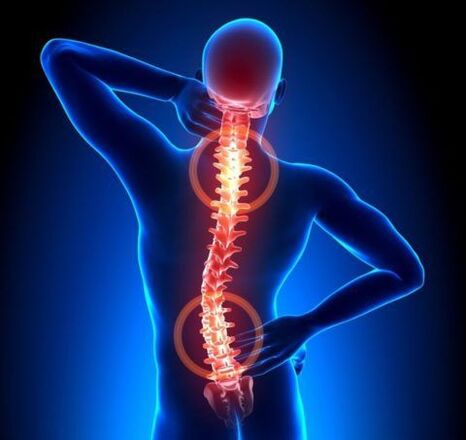
Many people aged 30 to 35 complain about back pain.The cause of these pains can be spine disease.Osteochondrosis is a disease that occurs in medium -sized people, but it is most frequently detected in patients after 40 years.
Osteochondrosis: What is this disease and what is your danger?
This term means a distribution process of cartilage and subject bone tissue.In modern medical practice, osteochondrosis is called degenerative-dystophical disease of the spine and intervertebral discs that play the role of the shock absorber.The danger of the disease is that the affected disk is almost impossible to restore, and without adequate treatment, disability is possible.
Is osteochondrosis a common disease?Statistics are not happy.About 85% of the population in the world suffers from this disease.
This disease is the most common form among all diseases that affect the spine.And according to the prevalence, it is immediately after the diseases of the cardiovascular system.
The essence of the disease
So, osteochondrosis: What is it?This is a chronic disease that affects the joints, more frequently the spine.
The spinal column consists of 24 vertebrae.Between the two vertebrae there is an album, whose purpose is the softening and depreciation of the loads.
Under normal conditions, the album is quite elastic and can support significant loads.In the center of the disc there is a pulp nucleus with a lot of water.For some reason, the nucleus loses its hydrophilic properties.
As a result, the album is delayed, decreases in height and deforms.In the posterior stages, the growth of bone tissue occurs with the formation of growth: osteophytes that compress peripheral nerves and spinal cord.This is what is the spine osteochondrosis.
The causes of pathology
Despite the fact that osteochondrosis is a fairly common disease, the reasons why the pathology is developed are not completely established.

The main factors are considered:
- excessive load in the column;
- wounds;
- Professional repeal: weightlifting or prolonged work in an uncomfortable and motionless possession;
- excess body weight;
- inheritance;
- Posture violation.
Osteochondrosis develops in one grade or another in almost all the people of the elderly and is one of the body aging processes.
Stages, forms and symptoms of disease development
Experts distinguish 4 stages of the disease:
- First stage- Move the disc nucleus to the edge;
- Stage 2- The appearance of cracks on the cartilage wheels and the instability of the vertebral section;
- Stage 3- A complete break with the loss of the nucleus in the stem of the spine, while the roots of the spinal cord are possible;
- Fourth stage- Approximate changes not only on the intervertebral disc, but also in the surrounding fabrics.
The main symptom of the disease is pain.It can be acute with high intensity or moderate and silly manifestation.
In addition to pain, there are:
- painful tension of the back muscles;
- skin numbness on arms and legs;
- limitation of movements volume;
- weakness in extremities muscles;
- Slimming of the arms and legs;
- Sudden dizziness.
These are general manifestations for all forms of pathology.Depending on the column in which the changes are located, three forms of the disease with characteristic symptoms are distinguished.
Table No. 1. forms of osteochondrosis and its inherent symptoms:
| Disease shape | Symptoms |
| Osteochondrosis in the neck | Changes in this department lead to pushing blood vessels and deteriorated microcirculation.For this reason, a person has constant dizziness.Sometimes this leads to fainting.There is noise in the ears and flickering colored spots in front of the eyes. |
| Osteochondrosis in thoracic vertebrae | With this form of disease, acute chest pain is observed.The disease can cause the progression of intercostal neuralgia and aggravate the course of heart pathologies. |
| Osteochondrosis in the lumbar region | The pathology in the lower back is manifested by pain in the gluteal region, a decrease in the tone of the IKR.A complication can be radical, which is accompanied by pain spreading throughout the leg. |
Due to the pathology of vertebral discs, there is a large number of body disorders: pinched nerves, swelling, circulatory rape and fibrosis of the surrounding tissues.These changes cause a variety of symptoms, which complicates the diagnosis and prescribes the appropriate treatment without a carefully exam.
Clinical manifestations
The symptoms of the disease depend on where the injury is mainly.In the sections below, we consider the characteristic signs of each variety of the disease.
The Uterine Department
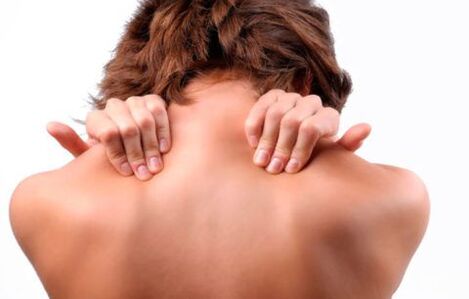
The main symptoms of damage to the cervical column include:
- discomfort, neck pain and shoulders;
- Muscle hypotone;
- greater sweating;
- fingertips of fingers;
- violation of the coordination of movements;
- Headaches, dizziness;
- Problems with hearing and vision;
- Hypertension.
With the progression of the disease and damage to nearby arteries and nerves, one of the following syndromes can be developed:
- vertebral artery;
- cardiac;
- hypertension;
- root;
- Cervical migraine.
The violation of blood circulation in the vertebral artery and this hypoxia of brain tissues are the dangerous consequences of osteochondrosis.
This syndrome manifests:
- Periodic system/dizziness;
- vision weakening;
- partial or complete auditory loss;
- Sometimes - fainting.
Important!The neurological manifestations of the vertebral spine osteochondrosis often have to differentiate themselves with cerebral atherosclerosis, DEP and other pathologies.
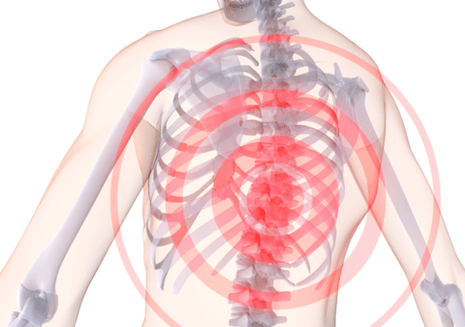
Thoracic region
Compared to other forms of the disease, thoracic osteochondrosis manifests itself less pronounced.
Among its symptoms:
- pain in the chest, increasing at night or with prolonged in a position;
- discomfort, a feeling of tightening among shoulder blades;
- Strengthen pain during deep breathing.
If the disease is not treated, it will progress, causing damage to the near and close nerves.
The signs of the development of complications of the osteochondrosis of the spine of this location can be:
- skin numbness in some areas, a feeling of "chicken skin";
- Leather picaquera, burning;
- limb cooling;
- Nail fragility;
- pronounced dry skin;
- pain along the esophagus and the pharynx;
- Gastrointestinal tract disorders.
In addition, the chest location of the disease is characterized by two specific symptoms: Dorsago and Dorsalgia.
Dorsago is a sudden, sharp and intense chest pain, a "chest change."It can occur with prolonged in the same position, monotonous work.
Pay attention!During infant, pain is so serious that patients are afraid to even take additional inhalation.
Dorsalgia is less intense, but monotonous painful sensations that can last up to 2-3 weeks.They intensify with deep breathing, inclinations.
Lumbar apartment
The osteochondrosis at the bottom of the column, namely, lumbar, occupies a leadership position in prevalence.
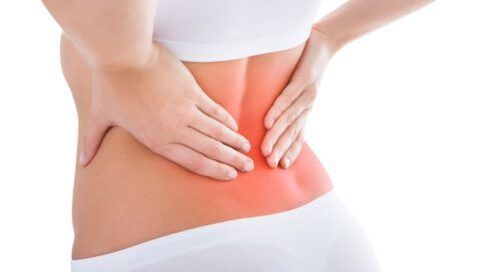
Among its characteristic symptoms:
- Offer, more often painful lumbar pain, radiating in the leg;
- discomfort, intensifying when changing the position of the body, sneezing, coughing, trying to lift weights;
- constant muscle spasm in the lower back;
- Lights in the lower back;
- Altered sensitivity in the skin of the buttocks, hips, legs, feet;
- a feeling of chicken skin tracking in the lower extremities;
- Dry, peeled from the skin.
The Sacred Department
The osteochondrosis of the sacral column is extremely rare in isolation and is generally a "continuation" of lower lower back damage.
This explains the characteristics of its symptoms:
- lumbar pain, as well as in the sealing nerve;
- "Sharp shelters" throughout the leg;
- an unpleasant sense of discomfort in the back of the thigh;
- lower limb numbness;
- Paresis, as well as unstable symptoms of deteriorated motor activity.
Important!The osteochondrosis of the lower column can lead to extremely dangerous complications such as blood supply deteriorated to spinal cord and compression myelopathy.

Common osteochondrosis
A common form or osteochondrosis of all parts of the spine is the most severe version of pathology.Due to the immensity of defeat, its image can be extremely diverse and include almost all the symptoms described above.
Diagnostic methods
The appearance of any complaint indicated above requires an appeal to a medical institution: the patient must examine the patient.The diagnosis of osteochondrosis should be complex and very thorough.
The standard instruction includes the following stages:
- Complaints and Anamnesis collection.
- Clinical inspection
- X -ray exam.
- Modern methods (CT, MRI).
When conducting a conversation with the patient, the doctor should find out:
- that bothers the patient;
- What is the most pronounced unpleasant sensations?
- What is its intensity and duration?
- that causes its strengthening;
- which helps face pain.
Important!Be sure to tell the doctor how long he worries such complaints and if he received any treatment before.
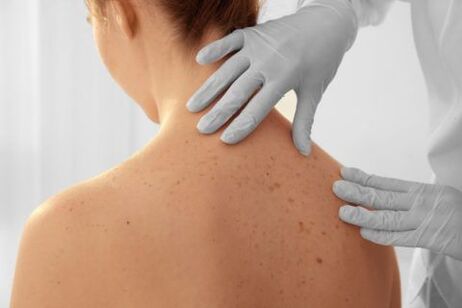
During a clinical inspection, the specialist evaluates:
- the position of the patient's body, its march, the volume of active and liabilities;
- the presence of skin defects, redness, peeled;
- symmetry of healthy and sick parts of the body;
- the presence of muscle spasm;
- the area of irradiation of pain;
- The presence of pain, temperature and other types of sensitivity.
During the radiography, each spine for a better visualization is studied individually.The images are made in direct, lateral and (as indications) of two oblique projections.To evaluate the stage and the severity of the degenerative changes, the X -ray classification of the osteochondrosis of the Zeaker spine is used.
Table: X -Cays of osteochondrosis of the column:
| Scenery | Description |
| Me (+) | Changes not expressed in lordosis in a small number of segments |
| II (++) |
|
| III (+++) | Expressed changes, significant narrowing of intervertebral holes |
| IV (++++) | Significant narrowing of intervertebral holes, massive exostosis, often irreversible changes |
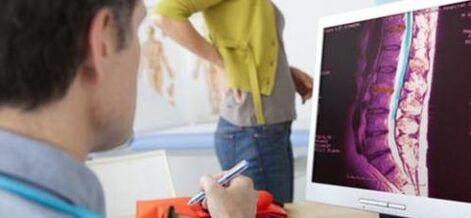
With the insufficient information content of the R image, the most modern-CT (specific images of one or more segments of the spine) and MRI can be prescribed to the patient (visual diagnostic method based on the properties of electromagnetic radiation).
Treatment
First, the doctor explains to the patient what is Osteochondrosis and how to treat it.Talk about a set of measures that must be made for a long period.
The disease therapy is carried out taking into account the stage.In the initial period of the disease, physiotherapy, physiotherapy and physiotherapy exercises are indicated.But as the dystrophic process progresses, several orthopedic devices must be used to immobilize the spine.Pharmacological treatment is also necessary.
Surgical intervention is indicated with complications and with the inefficiency of conservative treatment.
Medications
The most important tasks of treatment with pharmacological medications are pain relief, eliminating inflammation of nerve roots, restoring the structurality of the cartilage, improving blood circulation and nutrition, stopping the development of pathology.There are several groups of drugs that can be prescribed in this case.
In pharmacies, they are represented in several forms and in a wide variety.The price of medications can be different and can always choose the most affordable.
Table No. 2. Medications used in the conservative therapy of osteochondrosis:
| Pharmacological Group | Therapeutic effect | Instructions for use |
| Condroprotectors | Reduce the speed of cartilage degeneration processes, contributes to its restoration. | Take 1 capsule for a month.If necessary, the treatment course is repeated. |
| Aoño | It has an anesthetic effect, reduces the inflammatory process. | Take a paint for pain.With severe pain, intramuscular injections of the drug are used. |
| B Vitamins | Improves the conductivity of the nerve impulse, it restores microcirculation in the affected cartilage area. | The treatment course with intramuscular injections is carried out. |
| Musorelaxantes | Relax the muscles, relieve tension, facilitate pain. | Take a tablet 2 times a day. |
The medications are prescribed according to the doctor's testimony.The car -medical can be ineffective and, in some cases, even damage.
Physiotherapy for osteochondrosis
What to do with osteochondrosis, except for medications, to accelerate recovery?One of the most effective methods to treat this disease is physiotherapy.
Its advantage is a selective effect on the disease approach.Physiotherapy contributions to reduce pain, elimination of inflammation and increase general immunity.With their help, the muscles relax, metabolic processes and blood circulation are normalized.
For osteochondrosis, they are used successfully:
- Magnetotherapy;
- laser therapy;
- shock wave therapy;
- quartz;
- electrophoresis;
- The effect of low frequency electric currents.
Physiotherapy is not carried out if the patient is in serious condition, with an exacerbation of the disease, oncological diseases and mental disorders. In other cases, physiotherapy has a beneficial effect on the recovery process, improves the effect of medicines, which reduces their dose.
In other cases, physiotherapy has a beneficial effect on the recovery process, improves the effect of medicines, which reduces their dose.
Medical Physical Education
Physical education classes are prohibited in the acute period of the disease.After eliminating this period, the doctor prescribes therapeutic exercises, which develops together with the instructor individually for each patient.
With the help of the exercises, the muscle corset is strengthened, which avoids the curvature of the spine and allows it to distribute the load in the vertebrae correctly and uniformly.With regular physical effort, medicinal substances penetrate the column into higher concentrations than in their absence.
It is necessary to participate in the guide of an experienced instructor and carefully monitor your condition.With discomfort and severe pain, exercise must stop.
Prevention
Knowing what osteochondrosis and its consequences are, it will be useful to think about prevention.
Preventive measures are quite simple, they are easy to perform for all those who care about their health:
- injury prevention;
- regular physical training (swimming is very useful);
- maintain normal weight;
- Do not load the column;
- monitor posture correction;
- Not being in a position for a long time;
- Avoid sudden movements when lifting weights.
When complying with these rules, the referral period will be long.
Osteochondrosis is a fairly serious disease.But with the timely search for a doctor and adequate treatment, it is possible to stop its destructive effect.
You ask the doctor
Neck pain
Hello, tell me please.I am 24 years old.In recent months, the pain in the neck, the back of the head (sometimes still gives whiskey, eyes).I also notice a strong crunch in the neck, anthill and numbness of the hands, tongue and heaven.
I suspect that osteochondrosis, because both the mother and the grandmother of young people are tormented with similar symptoms.Where to start the exam?And another question: can I go to aerobics?
Make a R-Scheme store (CT) and Doppler of head and neck vessels.He probably developed vertebral artery syndrome in the context of cervical osteochondrosis.An additional plan for diagnosis and treatment can be developed only after obtaining the results of these tests.
It is better not to visit the aerobics yet.
Lumbar osteochondrosis
For seven years I have been tormented with the lower back, the exacerbation of the osteochondrosis is almost 2-3 months.Injections and tablets help for a short time, and then the pain returns.I work as a mailman, becomes more difficult.Am I putting disabilities?
Hello!The decision on the award of the Disability Group is taken by the UIT on the basis of a comprehensive study of its situation.You must first communicate with the therapist and undergo an exam.
As a general rule, with lumbar osteochondrosis, a disability group is not shown.Its prize is possible with the development of complications (bumps, intervertebral hernias, etc.).But, again, I repeat, everything is individual here.

























